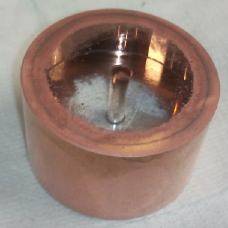
Home of the world famous 'finishing.com HOTLINE' since 1989
-----
Problems with copper on glass
May 22, 2012
Q. Hello,
I am a PhD student doing research for school. I was given a task by my advisor to plate a glass cylinder with copper for use in a laser system. The cylinder itself is about 1 inch in height and 2 inches in diameter with a small hole running down the center. The method that I have had some success with is as follows:
1. Clean the surfaces with acetone
⇦ on
eBay
or
Amazon
[affil link] Flammable!
. The surfaces are polished and need to remain so, etching is out of the question.
2. Use a vacuum evaporator to coat all of the surfaces. I believe I am getting at least .5 microns deposition when I finish.
3. I attach the cylinder to a threaded rod down the center using two led cones as contacts. This serves as my cathode for plating
4. My anode is six strips of copper that I arranged around a two gallon bucket, three of which are bent in an L shape so that there is some copper on the bottom of the bucket.
5. I use an acid copper sulphate
⇦ on
eBay or
Amazon [affil link] bath (what seems to be a standard recipe as far as I can tell) and a current density of 25 A/ft^2, which for my surface area (3.75 in^2) comes to about 1.7 A

I have had some success with this method, but lately I've been running into problems that I haven't encountered before and I know I need the help of experts. Basically, when I got to plate in the bath, the copper on the ends of the cylinder seems to be leaching into the solution. The sides will plate fine, it is always the ends. With no current running, the deposition layer doesn't dissolve away, as far as I can tell, it seems like the current is causing it to happen. These are possible issues I thought of and was wondering if they could be the cause:
1. The deposition was going towards the threaded rod and led contacts. I insulated them with wire casing
2. The current density is too high or low.
3. The cylinder is warm in temperature after the deposition, it may need to cool?
4. Similarly, the temperature is promoting a copper oxide layer, could this cause problems?
I have a picture of my cylinder after a failed plating. I had one side plated and the other leached out. After applying more deposition on the one side I plated once again and both sides leached.
Any advice would be greatly appreciated.
Thanks,
Ben
- Chicago, Illinois, USA
A. Hi Ben,
Your deposit layer is between your anode and cathode, induced current is produce during electroplating. some areas will cathodic, some areas will be anodic (bi-polar effect).
Recommend:
Thread your cathode rod on the opposite end (outside the cylinder).
Do you have solution agitation?.
Cut your current to 0.7 amps,
If you need to plate the inside of the cylinder, recommend to use an auxiliary anode.
Good Luck:
Hamilton,
Ex- Senior Chemist
Research & Engineering
- Mays Landing, New Jersey, USA
No dead threads!
Your Q, A, or Comment puts this thread on The Finishing.com HOTLINE.